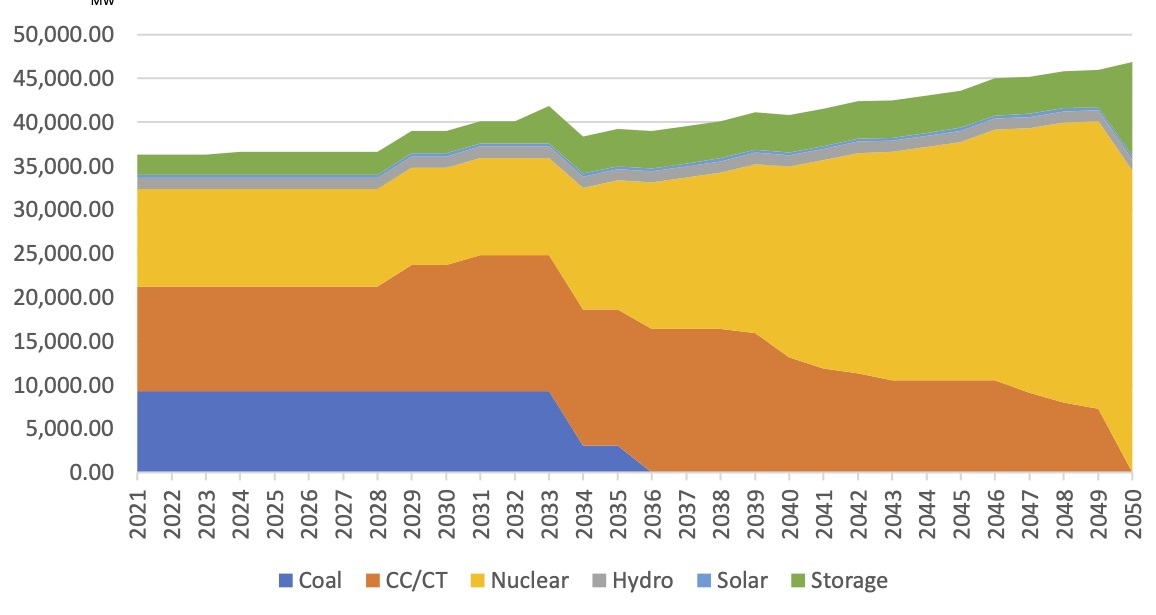The American Farmland Trust (AFT) ranked North Carolina second in the nation for farmland threatened from residential development. It’s a big concern. Agriculture is the state’s top industry, employing about one-fifth of the state’s workforce.
According to North Carolina Agriculture Commissioner Steve Troxler, North Carolina has about 8.3 million acres of farmland. Per AFT estimates, about 1.2 million acres of farmland could be lost to residential development by 2040. The state’s Agricultural Development and Farmland Preservation Trust Fund has preserved only 34,000 acres of working farmland so far.
Residential development isn’t the only big threat to our farmland, however. Troxler told Carolina Journal recently that the state had already lost 40,000 to 45,000 acres of farmland to solar facilities. The problem here is that state regulators are calling for Duke Energy Carolinas and Duke Energy Progress (Duke) to build unprecedented amounts of new solar as part of the state’s Carbon Plan.
Solar requires a lot of farmland for such an unreliable power source
It’s well-known that solar has a voracious appetite for land. The John Locke Foundation’s “Policy Solutions” estimated that while a 1,000-megawatt (MW), zero-emissions nuclear facility needs only one square mile and a natural gas facility needs just 1.7 square miles, a solar facility of that size in North Carolina takes up over 13.2 square miles — or about 8,500 acres. As a reminder, that estimate is for 1,000 MWs of new solar. Individual solar facilities tend to be much smaller and dotted across the growing region. Also, the amount of new solar under discussion is much, much larger.
The initial Carbon Plan handed down by the North Carolina Utilities Commission (NCUC) on the final day of 2022 called for Duke Energy Carolinas and Duke Energy Progress (Duke) to procure 2,350 megawatts (MWs) of new solar generation to be placed into service by 2028. It’s a huge amount — two and a half times greater than the largest amount of solar Duke has ever interconnected in a single year. That directive also came one month after the NCUC had ordered Duke to procure 1,200 MWs of new solar generation.
The total amount of new solar Duke was ordered to procure is 3,550 MWs. That amount could potentially threaten as much farmland as has been preserved by the trust.
Going further, by 2038 Duke’s proposed updated integrated resource plan for the Carolinas would add 17,500 MWs of new solar (some in South Carolina). If that were to happen, it would eliminate around 150,000 acres of farmland.
Solar facilities’ enormous land footprints mean they need to be built away from population centers and therefore require new transmission lines to be built. Solar is also an intermittent power source. Solar facilities produce what they can when they can, based on weather conditions and time of day. As Strata Solar disclosed in its application to build a solar farm on Gov. Roy Cooper’s Nash County property: “Solar is an intermittent energy source, and therefore the maximum dependable capacity is 0 MW.”
Intermittency is a major problem. The coal plants Duke is directed to close are all baseload power sources. That means they, like nuclear, are the workhorse power plants, the ones supporting the state’s known underlying demand for electricity at any point in time. Additional variations of demand above the baseload level can be covered by dispatchable sources, natural gas and hydroelectric. Dispatchable is the opposite of intermittent; a dispatchable source can be ramped up and down quickly in response to fluctuations in electricity demand.
Nevertheless, intermittent solar is being pushed very hard politically with subsidies, laws, and regulations. Replacing one reliable, dispatchable power plant takes numerous solar facilities of the same size just to approximate the productivity lost. A recent brief on reliable power generation discussed this problem.
If politics forbids reliable power generation, then the only answer is to throw a lot of expensive redundancy into the system. That is, overbuild. Charge ratepayers to construct eight facilities in the hopes of getting the stated capacity of one. You’re still not getting any solar production from evening through morning, though.
Overbuilding also requires lots more transmission infrastructure. Duke rates are already increasing, and Duke officials explained it is mostly because of grid infrastructure improvements and new solar facilities (they opted for the “transitioning to clean energy” euphemism). The NCUC’s staff has publicly warned that electricity rates could be “approximately double” by the end of the decade.
How to preserve farmland, agriculture jobs, and reliable power
For these reasons, Locke’s Center for Food, Power, and Life modeled to the NCUC how to achieve the Carbon Plan’s goals with less cost and more reliability: Add more zero-emissions nuclear power, pumped storage, battery storage, and natural gas facilities, rather than overbuild solar and wind.
Model Least-Cost Decarbonization Portfolio: Nuclear, Pumped Storage, Battery Storage, and Natural Gas

Locke’s top recommendation for electricity policy is to pass a law that would:
Require that any retiring source of baseload power generation be replaced with an equal or greater amount of new baseload generation, commensurate with increased electricity demand.
These solutions would also help preserve North Carolina’s vital but dwindling farmland in the coming years.
Correction note: The actual estimate of square miles needed for 1,000 MWs of solar in North Carolina made for the Policy Solutions report was 13.2 square miles. The estimate originally cited here of 49.0 square miles for 1,000 MWs of solar actually was based off this report by Strata Policy, which used the estimate of “31.347 acres per megawatt of solar electricity produced.” That figure was erroneously placed in the Policy Solutions table instead of the Locke estimate. We regret the error.